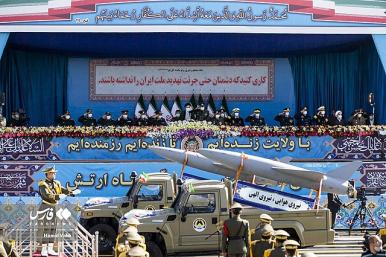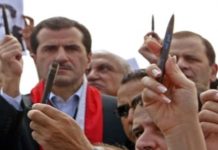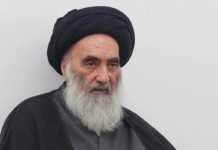Home تعليقات ومقالات مميزة عمر الرداد/معهد واشنطن: التداعيات الإقليمية للطائرات الإيرانية المسيرة في أوكرانياOmar Alradad/Washington Institute:...
التداعيات الإقليمية للطائرات الإيرانية المسيرة في أوكرانيا
عمر الرداد/معهد واشنطن/08 كانون الأول/2022
The Regional Impact of Iran’s Drones in Ukraine
Omar Alradad/Washington Institute/December 08/2022
Russia’s use of Iranian drones in Ukraine foreshadows potentially dangerous developments for U.S. forces and their allies in the Middle East.
After months of denial, Iran’s foreign minister acknowledged on November 5 that they had supplied Russia with drones. Prior to this, the Supreme Leader of Iran had made several statements concerning the use of Iranian-manufactured drones by Russian armed forces in Ukraine, but these statements only highlighted the power of Iran’s drone system. They included saying that “those who used to say that photos of Iranian drones were created and modified in photoshop now warn that they are dangerous,” and “they wish to hold Iran to account by asking why it sells weapons to one party or another.”
The Supreme Leader had all but verified Ukraine’s claims in this praise, but the foreign minister’s admission officially put to rest any lingering doubts in the absence of evidence from Ukraine or Iranian counter-evidence, especially after the flood of initial statements by the Iranian Ministry of Foreign Affairs, with support from the Representative of Iran to the United Nations, attempted to deny that Iran had provided Russia with any missiles or drones. Notably, this attempt to deny drone use echoed Iran’s longstanding denial of supplying missiles to Houthi forces in Yemen. Now, Ukraine has become a means for Iran to conduct live tests of its drone fleet against defense systems supplied by the United States and NATO.
Iranian drones—particularly kamikaze drones—are a potent mix of efficacy and affordability, at an estimated cost of $20,000 per drone. Of course, these drones do have shortcomings, including their inability to carry explosives weighing more than 50 kilograms and the slow speeds that make them easily detectable. However, while individual drones make easy targets, sending a large number of drones per raid makes the drones significantly more dangerous, in keeping with the military approach that it is sufficient to strike 20 percent of one’s targets.
Moreover, Iranian leadership has practiced doublespeak regarding the drone issue, with the Supreme Leader expressing Iranian public opinion and praising drone manufacturers in his comments on the situation while the Ministry of Foreign Affairs uses a more diplomatic discourse. For the rest of the region, Iran’s handling of the message is particularly important given the ways that Iran has exploited the Ukraine issue to project certain messages about itself. In particular, it seems that Iran has aimed to situate themselves as a partner or affiliate of a ‘new world order’ viz-a-vis Moscow and Beijing. This message is undoubtedly directed at the West, portraying Iran as a power capable of playing a game-changing role in both regional and international conflicts, especially if the nuclear negotiations don’t go their way. However, this message is also clear to those wary of Iranian military buildup on their eastern borders.
The use of Iranian drones in Russia’s war against Ukraine has provoked crucial questions in Middle East military circles. More specifically, regional forces—including U.S. forces in the Middle East, the Gulf states, and Jordan—have been attempting to gauge the true extent of the threat posed by these Iranian drones for some time now. While previous data was somewhat limited, their regional deployment has provided a growing series of successful attacks, including effective strikes in Saudi Arabia and the United Arab Emirates. It has also been widely reported that drug smuggling gangs in Jordan linked to Iran and Syria have been actively launching drones from southern Syria towards Jordan since the beginning of the year.
At least some of Iran’s drones have proved similarly effective in striking their Ukrainian targets. In light of Iran’s policy of hostility towards Gulf countries, especially, the availability of this weaponry to Iran-allied militias would further disturb the security and stability of the entire region.
Of course, this will put Arab armies in front of new challenges regarding ways to confront Iranian drones, and they must search for solutions, including importing drones from the United States and European countries. Some may even buy Israeli or Turkish planes and technology to confront Iranian weapons, especially since the Ukrainian army has reportedly seen success with these technologies. Such developments could spark a new arms race in the region similar to the nuclear and missile race.
In the immediate context, it is unlikely that Iran’s drones will cause major strategic shifts in the war in Ukraine. Russia is using them specifically to strike civilian targets and to destroy Ukrainian infrastructure in an attempt to break the people’s will. Furthermore, the United States and NATO countries have many ways to deal with the Iranian drones on a practical level—including new Euro-American sanctions on Iran and on the individuals and entities responsible for the Iranian drone development program, as well as presenting the issue to the UN Security Council.
Nevertheless, these measures have not been entirely sufficient. Ukraine must obtain better military aid to deal more effectively with Iranian drones. Since these drones are technically simplistic and poor quality, defense technologies would do wonders in Ukraine’s fight against new threats. And looking further afield, the United States, NATO, and regional militaries must also work to strengthen their own capacity to combat Iranian drones and disrupt Iran’s drone program. This program will likely be used against the United States and its allies in the Middle East in the future.
التداعيات الإقليمية للطائرات الإيرانية المسيرة في أوكرانيا
عمر الرداد/معهد واشنطن/08 كانون الأول/2022
يُنذر استخدام روسيا للطائرات الإيرانية المسيرة في الحرب في أوكرانيا، بحدوث تطورات من شأنها أن تشكل خطورة على القوات الأمريكية وحلفائها في الشرق الأوسط.
بعد شهور من الإنكار، أقر وزير الخارجية الإيراني في الخامس من تشرين الثاني/ نوفمبر بأن بلاده زودت روسيا بطائرات مسيرة. قبل ذلك، أطلق المرشد الأعلى للثورة الإسلامية في إيران عدة تصريحات حول قضية استخدام القوات الروسية طائرات مسيرة إيرانية الصنع في أوكرانيا. ومع ذلك ، القت رسالة المرشد الضوء على مدى قوة نظام المسيرات الإيرانية خاصة حين قال” إن من كان يقول إن صور المسيرات الإيرانية الصنع مفبركة ومعدلة بالفوتوشوب يحذر الآن من خطورتها، مضيفا أن هؤلاء يريدون محاسبة إيران من خلال مساءلتها لماذا تبيع أسلحتها لهذا الطرف أو ذاك.” وبالطبع اكدت تلك التصريحات مزاعم اوكرانية بهذا الخصوص.
وقد أدى ذلك إلى تبديد أي شكوك عالقة حيال المسيرات الإيرانية إلى حد كبير وذلك في ظل غياب أي أدلة أولية من جانب أوكرانيا إلى جانب الجهود المبذولة من قبل إيران ووزارة خارجيتها لتقديم أدلة مضادة، وهو الموقف الذي اكده مندوب إيران لدى الأمم المتحدة حيث حاول في البداية يائسا إنكار تزويد إيران لروسيا بأي صواريخ وطائرات مسيرة. والجدير بالذكر أن محاولة إنكار إيران استخدام الطائرات المسيرة في اوكرانيا تتشابه مع موقفها طويل الأمد حيال تزويدها قوات الحوثيين في اليمن بالصواريخ. والآن، صارت أوكرانيا ساحة معركة أخرى لإجراء تجارب حية لأسطول طائراتها بدون طيار ضد الأنظمة الدفاعية التي توفرها الولايات المتحدة وحلف شمال الأطلسي.
تعتبر المسيرات الإيرانية، وخاصة طائرات كاميكازي – مزيج قوي من الفعالية والقدرة على تحمل التكاليف، حيث يقدر ثمن الطائرة الواحدة بعشرين ألف دولار، ويمكنها حمل أكثر من” 50 “كلغم، من المتفجرات، ويسهل انكشافها بسبب بطئها. وفي حين أن الطائرات الفردية المسيرة غالبا ما تكون هدفا سهلا، فإن إرسال عدد كبير من الطائرات المسيرة في كل غارة يجعلها -وفقا للمقاربة العسكرية – أكثر خطورة ويكفي ليحقق 20% من أهدافه.
تتبنى القيادة الإيرانية خطابا مزدوجا بين مقاربة المرشد الاعلى” التي تتضمن رسالة للراي العام الايراني والثناء على كوادر صناعة الطائرات المسيرة” والخطاب الدبلوماسي الذي تمارسه وزارة الخارجية. بالنسبة لبقية المنطقة، فإن معالجة إيران لتلك الرسالة يعتبر امرا ذو أهمية، خاصة أن إيران استغلت تلك القضية لترسل رسائل أخرى من بينها انحيازاها باتجاه موسكو وبكين في إطار نظام عالمي جديد، وهي رسالة موجهة للغرب وتستهدف العودة لمفاوضات النووي، بوصف إيران قوة قادرة في حال استمرار عرقلة الاتفاق، ليس فقط باتجاه لعب ادوار في الاقليم، بل أيضا في الصراعات الدولية، كالصراع في أوكرانيا.
ولعل ما ينبغي الإشارة إليه أن الإعلان عن مشاركة مسيرات ايرانية إلى جانب الجيش الروسي في حربه على اوكرانيا، طرح تساؤلات في اوساط عسكرية في الشرق الاوسط، بما فيها القوات الامريكية في المنطقة، ودول الخليج والاردن، حول ضرورة مواجهة هذا الخطر. وفي حين كانت البيانات السابقة حول تلك المسيرات محدودة إلى حد ما، إلا ان هذه المسيرات قد نجحت سابقا في الوصول لأهداف في المملكة العربية السعودية ودولة الإمارات العربية، وتردد على نطاق واسع في الاردن انه تم استخدامها من قبل عصابات تهريب المخدرات” المرتبطة بإيران وأوساط رسمية سورية” والتي نشطت هذا منذ بداية العام الحالي، انطلاقا من الجنوب السوري باتجاه الأردن.
وبالطبع سيضع ذلك الجيوش العربية أمام تحديات جديدة تتعلق بسبل مواجهة الطائرات الإيرانية المسيرة، والبحث عن حلول بما فيها استيراد طائرات مسيرة من أمريكا والدول الأوروبية، وربما تذهب بعض لشراء طائرات وتكنولوجيا إسرائيلية او تركية، حيث يتردد أن الجيش الأوكراني قد حقق نجاحات كثيرة من خلال استخدام المسيرات التركية أثناء مواجهاته مع القوات الروسية، وهو ما يعني بداية مرحلة جديدة من سباق التسلح في المنطقة، على غرار السباق النووي والصاروخي.
أثبتت بعض الطائرات الإيرانية المسيرة فعاليتها في ضرب أهداف أوكرانية. وفي ظل السياسة الإيرانية العدوانية تجاه دول المنطقة وخاصة دول الخليج، فإن إتاحة تلك المسيرات للمليشيات الموالية لإيران من شأنه أن يزعزع أمن واستقرار المنطقة برمتها، وهو احتمال غالبا ما يثير قلق القوى الإقليمية.
علاوة على ذلك، من غير المرجح أن تسفر تلك المسيرات عن حدوث تحولات استراتيجية كبيرة في الحرب في أوكرانيا، لكن روسيا تستخدمها فقط لضرب أهداف مدنية أهدافًا مدنية وتدمير البنية لكسر إرادة الشعب الأوكراني. ومع ذلك، تمتلك الولايات المتحدة ومعها دول الناتو سيناريوهات عديدة للتعامل مع الطائرات الايرانية، من بينها تلك العقوبات الامريكية والاوروبية الجديدة على إيران والكيانات والافراد المسؤولين عن برنامج إيران في تطوير المسيرات، ودفع هذا الملف إلى مجلس الامن والامم المتحدة.
ومع ذلك، لن تكون تلك الاجراءات كافية، إذ أن المطلوب امريكيا في هذه المرحلة ان تتضمن المساعدات العسكرية الاوكرانية منظومات دفاعية جديدة، بما فيها من تقنيات تستطيع ان تتعامل بفاعلية أكبر مع الطائرات الايرانية المسيرة، لا سيما وأنها مسيرات بمستويات جودة وتقنيات منخفضة. كما ينبغي على الولايات المتحدة وحلف شمال الأطلسي العمل على تعزيز قدراتهما المضادة للمسيرات الإيرانية والعمل على إبطاء برنامج المسيرات الإيرانية التي قد تستخدم في المستقبل لاستهداف المنشآت الأمريكية في المنطقة.
**عمر الرداد هو عميد سابق في مديرية المخابرات العامة الأردنية وهو الآن محاضر في الأمن الاستراتيجي. وتركز كتاباته على المسائل الأمنية الإقليمية. عمر هو أحد المساهمين في منتدى فكرة.






















